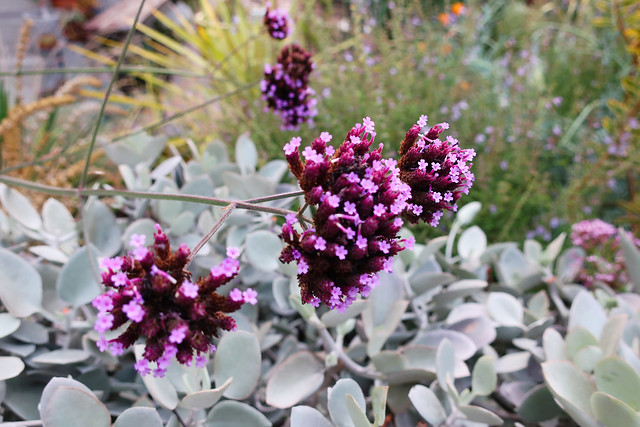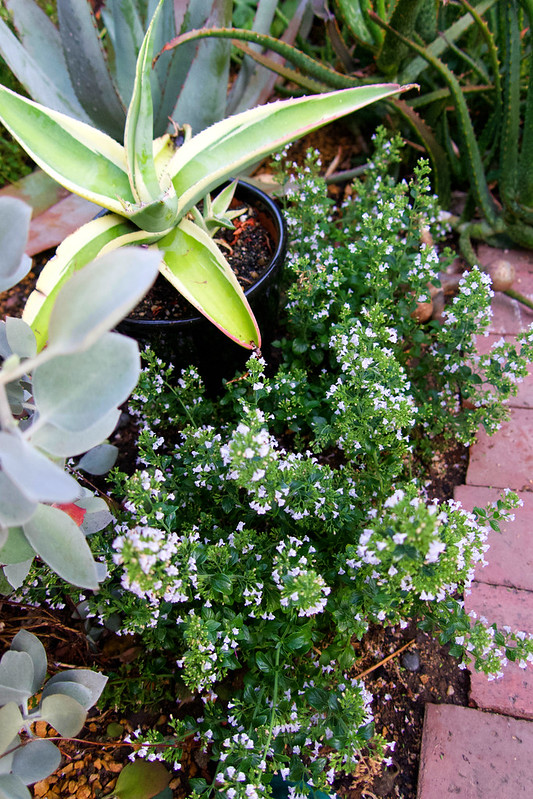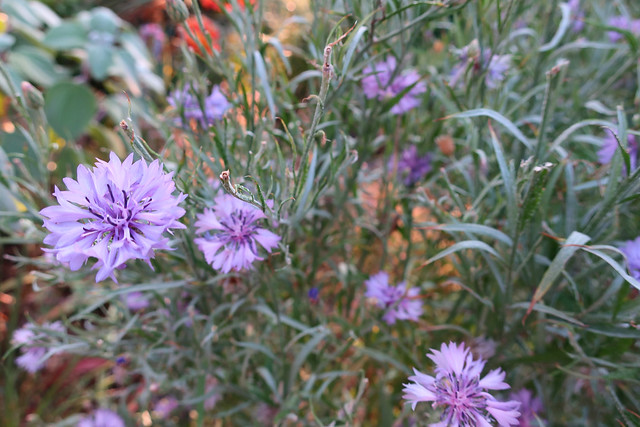With the drought tightening its grip, Californians have been asked to cut water use by 15 percent compared with last year. Even so, yesterday I let a hose trickle to deep-water parts of the garden, which was getting by on strategic spraying of mostly new plantings and containers up till now. And I’ve been continuing with new planting even into July, filling the holes repeatedly with water before settling in a couple new passifloras. (After all, the government encourages us to consider the benefits of “Using Trees and Vegetation to Reduce Heat Islands,” and I think maintaining a cooling biomass balanced with smart resource management is an important discussion to have now.) Last month’s water bill had us pegged at using 165 gallons a day. The average usage per person is roughly around 100 gallons, so we’re doing okay considering it’s a summer water bill.
I blew past the Bloom Day deadline, July 15th, a meme inspired by garden writer Elizabeth Lawrence’s conviction that we can have flowers nearly every month of the year (hosted by May Dreams Gardens). So I’m adapting for a more general, state-of-the-July-garden post. Judging by these photos, my floral contributions tend toward the small bordering on inconspicuous anyway, which is usual year-round and especially so in July — except for this year’s agapanthus (no new photos, sorry!) and lilies.
Incredibly photogenic, lilies are shameless tarts for the camera.
Unlike this shy salvia, beloved of all manner of winged insects, a workhorse in bloom since early spring that hates the camera. Doesn’t mind being cut back and is quick to rebloom, always keeps its leaves in good nick, and doesn’t aim to be anything flashier than an enduring blue scrim among the succulents.
Another workhorse is Verbena bonariensis, the butterfly-attracting champ of the garden. I imagine that all this pollinator talk can seem to the uninitiated like empty virtue signaling, but really the ongoing show of winged exuberance is just as alluring as anything else about the garden. I was out with a friend recently and was taken aback when she shouted, “Look, a butterfly!” like it was a rare, wondrous sight. Grow a pot of Verbena bonariensis and you can visually gorge on the creatures every day. Or, omg, the passion flower vines or the milkweeds or the native buckwheats…
Eryngium, probably E. planum, has seeded among the succulents.
Centranthus lecoqui is allowed to seed a couple plants here too.
Calamint earns a buzz of gratitude from my bee friends, and I love how it handles a hot dry summer without becoming disheveled. I often find Billie standing here, studying the bees’ micro-aeronautics — or possibly wondering if they’re good to eat. Let’s hope she never attempts to find out.
I’m resolved to annuals blooming a month, maybe two here in zone 10b, and that’s with optimally cooler temps and deadheading them like crazy to prolong their life. Spring Sweet peas, orlaya, cerinthe, summer cosmos — they all act like guests fidgeting to leave the moment they arrive. So I expected nothing less from bachelor buttons, but they’ve turned out to be that rare annual that segues from spring into summer. Fluke or not, I’ve ordered seeds of the dark maroon variety for next year.
Though I’m not sure where exactly I could squeeze in a few more bachelor buttons. These are growing against the east fence, bulging into the access path at the base of the fence that I’d like to keep clear. Maybe they’ve been successful due to the reflected heat of the fence?
Alstroemeria ‘Indian Summer’ is throwing a few more blooms, even after I had pulled every last leaf from the clump.
Euphorbia ‘Diamond Frost’ has perennialized in the garden going back years, a foaming patch busy with hoverflies.
The horned poppies are blooming in yellow, Glaucium flavum, and this orange, Glaucium flavum var. aurantiacum.
The bloom trusses on Eryngium pandanifolium seen to be maxing out at about 3 feet this year, possibly as a result of thinning the massive clump back to two rosettes. In the past they’ve always topped 5 feet.
When its lower leaves started browning in early July, I began pulling them off then ultimately decided to cut Nicotiana mutabilis down and slipped some cosmos in the vacated space that had been covered by its considerable wingspan. It was purely a judgment call, because even as the flowering tobacco’s stalks grew increasingly leafless, they still carried plenty of flowers for the hummingbirds. This nicotiana was hands down a stunning, long-blooming success. Just one plant kept the hummingbirds busy from early spring/March to July, developing an enormous cloud of blooms that was great value for a small garden. It’s uncertain whether it’s become exhausted by the effort or will return with strong basal growth and rebloom in fall, because it can be perennial here in zone 10b. But I might have to start over with new plants.
Solanum pyracanthum is never without a couple flowers, even in the middle of winter.
Anigozanthos ‘Tequila Sunrise’ fronted by the sexy outline of Agave salmiana var. ferox ‘Medio Picta’
I’ll close with this young, not-yet-imposing specimen that unexpectedly came to join the ranks under my pergola. I thought it might be fun to have a flutter on the JC Raulston Arboretum online rare plant auction a couple months ago. I’ve never gambled or attended any kind of auction, but the opening bids looked reasonable, $10, $20, the interface was super easy to navigate, and I thought maybe I could skate away with this very rare Brassaiopsis hispida for cheap. (Ha!) Jimi Blake at Huntingbrook in Ireland, via his Instagram feed, is where I first heard of brassaiopsis, but not this species. My low bid held until the last day of the auction, which is when the seasoned players get serious. The numbers began moving up into the 100s and beyond, and I bailed. Some of the rare agaves were bidding for astronomical amounts, and as the deadline for the auction loomed the bids were firing by second by second. It really was so much fun just watching the auction dynamics. Looking around for more info on the plant that got away, I discovered that Far Reaches Farm carried it for much less than the winning bid. Which is how paying under three figures came to feel like a steal — good thing I don’t gamble! It will be so exciting to watch how this member of the araliaceae family matures and whether it likes my garden…
Have a great weekend!




































I continue to be amazed at the things you can grow that I can’t even though we’re relatively close geographically speaking, but then I can’t grow a number of things I grew in my former garden just 15 miles north either. I can’t tall you how many times I’ve tried Eryngium, for example. I’m currently trying Verbena bonariensis (in a dwarf form) for the third or fourth time and I think I may actually have a chance of hanging onto it this time, as long as I can keep the rabbits at bay. I love the flowers of Cotyledon pendens and Begonia ‘Red Fred’. Best wishes for a nice weekend, Denise.
Garden looks fabulous. You do so much fabulous with every inch of space.
@Kris, I think the difference in what we can grow is partly explained by my little garden being enclosed and yours being very exposed! It took me a while to get V. bonar going, and the reseeded plants are best, but still I’ve seen way better specimens elsewhere, much more dense and floriferous. I saw a stand at Digging Dog near Mendocino and had to ask what it was!
@Hoov, we’ve had a fairly easy summer so far, right? Thanks for the kind words — I like filling every available space that’s not needed for humans with plants!
Yours is the second mention of Brassaiopsis hispida of the morning. One of the Alternative Eden guys posted a photo of Brassaiopsis hispida variegated on Facebook. I’m not quite on the bandwagon with this plant, but I’m glad you got one!
Stunning garden photos, a couple of times I found myself wanting to turn your camera slightly to the left or right, wanting to see more of a vignette just slightly clipped. Oh to visit your garden again!
The garden is looking fabulous with so many interesting and different plants. Love Begonia ‘Red Fred’ and the many different Aloes and Agaves. Bachelor Buttons grow readily here, almost too well, seeding around abundantly every year. The bees go nuts over them. They are not in the least fazed by the hot, very dry smokey summer we are having either. From it’s understated appearance wouldn’t think Brassaiopsis would generate such high prices.
@Loree, I succumbed to auction fever! I’m curious about all these new aralias, whether the leaves can handle even dappled sun here or need full shade. My trevesia is browning less on the tips as it matures so that’s a good sign. A lot of times what I want to show doesn’t photograph well because the light is wrong, etc, so the post is driven by what’s usable. And I’m absolutely convinced we will all be in each other’s gardens again!
@Elaine, that’s good to know about bach buttons. They may go into rotation here! You’d think I’d have gotten around to trying them in 30 years…yes, that brassaiopsis purchase might have been a bit of folly, but the whole episode was so entertaining!